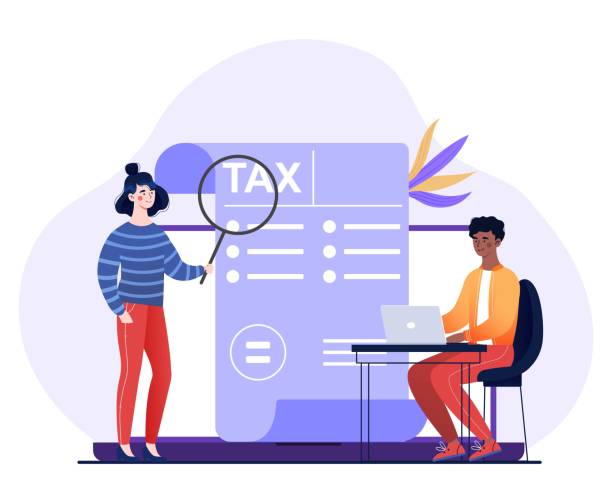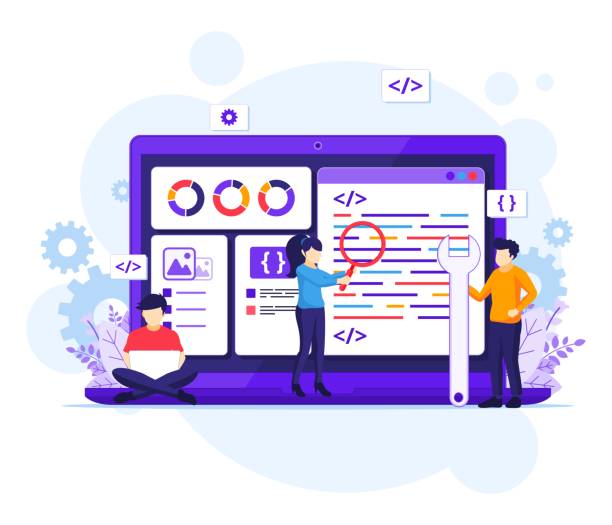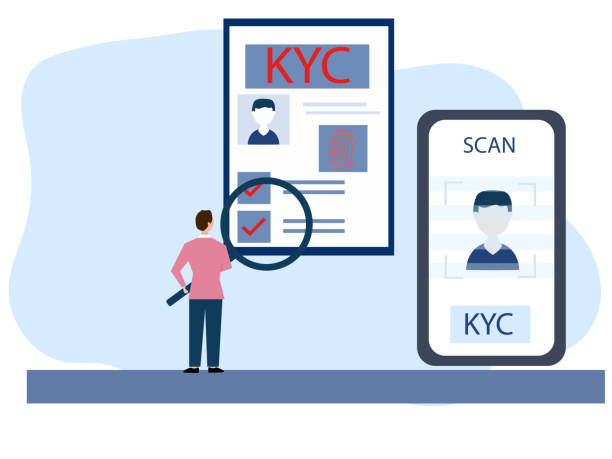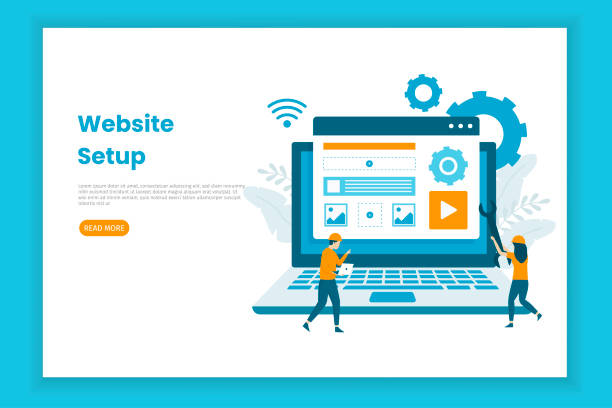Why Do We Need Professional Website Design?

In today’s rapidly digitalizing world, having a powerful online presence is no longer a luxury, but a vital necessity for any #online_business, organization, or even individual who wants to be seen in today’s competitive landscape.
Professional website design is not just about having a beautiful web page, but about creating an exceptional user experience that attracts visitors and converts them into loyal customers or followers.
An inefficient or unprofessional website can quickly drive visitors away and damage your brand’s credibility.
This educational section helps you better understand the importance of this topic and why investing in professional website design is considered a fundamental step for success in the digital age.
From increased accessibility to enhanced credibility and reaching wider markets, the benefits of a well-designed website are countless.
In fact, your website is the digital storefront of your business and creates the first impression of you in the audience’s mind.
Therefore, choosing a specialized team for this task is crucial.
Research shows that 80% of customers trust companies with professional websites more. Does your current site inspire this trust?
With Rasaweb’s corporate website design services, permanently solve the problem of customer distrust and a weak online image!
✅ Create a professional image and increase customer trust
✅ Attract more sales leads and grow your business
⚡ Get free consultation
Key Stages in Professional Website Design

The process of professional website design involves several distinct and interconnected stages, each playing a vital role in the project’s ultimate success.
Understanding these stages is a valuable guide for anyone planning to launch or update their website.
This process begins with information gathering and initial planning, continuing through launch and post-launch support.
The first stage is research and planning, which includes defining goals, identifying target audiences, and competitor analysis.
Following this, the User Experience (UX) and User Interface (UI) design stage takes place, where the overall look, navigation, and visual appeal of the website are shaped.
Then comes development and coding, where visual designs are converted into executable code.
The fourth stage is testing and QA, performed to ensure the website functions correctly across various browsers and devices.
Finally, the website launch and maintenance occur.
This comprehensive explanation of the stages helps you approach your professional website design project with a clearer vision and realistic expectations of the process.
Planning and Strategy for a Successful Website

At the heart of every successful professional website design project is a solid plan and strategy.
Without a clear roadmap, even the best designs may fail to achieve their goals.
This analytical and specialized stage involves several key elements that must be carefully considered.
The first step is defining the website’s goals; is your goal to sell products, provide information, or create a communication platform? Each goal requires a different design approach.
Next, you need to identify your target audience.
Their age, gender, interests, and needs should play a role in design decisions.
Competitor analysis is also highly important; reviewing competitor websites can reveal their strengths and weaknesses and help you create a distinctive and superior website.
Finally, a content strategy for the website must be developed.
What kind of content will you provide and how will you organize it? This precise planning provides a strong foundation for an efficient and professional website design.
This structured approach prevents resource wastage and paves the way for achieving your business goals.
| Key Element | Description | Importance in Professional Website Design |
|---|---|---|
| Goal Setting | Precisely defining what the website is intended to achieve (sales, awareness, lead generation). | Defining direction and focus for the entire project and measuring success. |
| Target Audience Identification | Understanding the characteristics, needs, and behaviors of potential visitors. | Designing appropriate User Experience (UX) and relevant content. |
| Competitor Analysis | Reviewing competitor websites to identify strengths, weaknesses, and opportunities. | Gaining competitive advantage and innovative ideas. |
| Content Strategy Development | Planning for the type, tone, format, and timing of content publication. | Attracting and retaining audience and improving SEO. |
| Budget and Time Estimation | Allocating necessary financial and time resources for each project phase. | Efficient project management and preventing delays. |
The Importance of User Experience (UX) and User Interface (UI) in Website Design

User Experience (UX) and User Interface (UI) are two fundamental pillars in professional website design that are often confused with each other, but each plays a distinct role in the website’s success.
UX refers to the overall user experience when interacting with your website, including ease of use, efficiency, and user satisfaction.
Good UX ensures that visitors can easily find what they are looking for and enjoy using your website.
In contrast, UI refers to the look and feel of the website; it includes colors, fonts, element layout, and all visual components that the user interacts with.
An attractive and appropriate UI is the first thing that catches a user’s attention and encourages them to continue exploring the website.
This is the most specialized aspect in attracting and retaining users.
The successful combination of these two factors leads to the creation of a user-friendly and pleasant website that is not only beautiful but also effectively meets your business goals.
Education in UX/UI is essential for every website designer and business owner to be able to design a truly successful and user-centric website and implement a professional website design in the best possible way.
Do you have an e-commerce site but your sales aren’t as expected? Rasaweb solves your problem permanently with professional e-commerce website designs!
✅ Significant increase in conversion rates and sales
✅ Unparalleled user experience for your customers
⚡ Click for a free consultation with Rasaweb!
Choosing the Right Technologies for Professional Website Design

Deciding on the technologies to be used is one of the most important stages in professional website design.
The choice of platforms, programming languages, and tools directly impacts your website’s scalability, security, speed, and maintainability.
This section provides specialized guidance for smart selection of these technologies.
You can choose between using Content Management Systems (CMS) like WordPress, Joomla, or Drupal, or developing a custom website from scratch (using frameworks like React, Angular, Vue.js for frontend and Laravel, Django, Node.js for backend).
CMSs are suitable for quick and easy launch, but may have limitations in customization.
In contrast, custom development offers unlimited flexibility but requires more time and cost.
Other factors such as the need for a database (like MySQL or PostgreSQL), server type (Apache, Nginx), and version control systems (like Git) must also be considered.
The correct choice of these technologies lays the foundation for a powerful and forward-thinking professional website design.
This decision should be based on the specific project needs, budget, and long-term business goals.
Creating Engaging and SEO-Friendly Content for Your Website

Content is king; this statement holds completely true in the world of professional website design and SEO.
No matter how beautiful and technically advanced your website is, without valuable and engaging content, it cannot attract and retain audiences.
This educational and thought-provoking content section addresses the importance of producing SEO-friendly content.
Your content should not only be engaging and informative for users, but also optimized in a way that search engines can easily understand and rank it.
This includes intelligent use of keywords, writing compelling titles and meta descriptions, and properly structuring content using H1, H2, and H3 tags.
Types of content can include blog articles, product pages, videos, infographics, and podcasts.
Entertaining content can reduce bounce rates, while specialized content can increase your credibility.
The ultimate goal is to create content that answers users’ questions, solves their problems, and encourages them to take a specific action (like purchasing or signing up).
A professional website design always considers content creation an inseparable part of its strategy.
Website Optimization for Search Engines (SEO) and Increased Traffic

Search Engine Optimization (SEO) is one of the most crucial aspects of professional website design that helps your website rank higher in search results and attract more organic traffic.
This is a specialized and analytical process that shows its results over time.
SEO consists of two main parts: On-Page SEO and Off-Page SEO.
On-Page SEO includes all optimizations performed within the website itself, such as keyword optimization, page loading speed, responsiveness, URL structure, title tags, meta descriptions, and content structure.
In contrast, Off-Page SEO refers to activities performed outside your website, such as link building from other reputable websites, social media activity, and increasing domain authority.
For a professional website design, both aspects must be carefully considered.
Using analytical tools like Google Analytics and Google Search Console is essential for monitoring performance and identifying improvement opportunities.
By following SEO best practices, you can ensure that your website is appealing to search engines and reaches your target audience.
| Feature | On-Page SEO | Off-Page SEO |
|---|---|---|
| Definition | Optimizing elements within the website to improve ranking in search results. | Activities outside the website to increase its authority and standing. |
| Examples | Keywords, title tags, loading speed, mobile compatibility, URL structure. | Backlinking, social media sharing, content marketing. |
| Control | Full control by the website owner or design team. | Requires interaction with other websites and users. |
| Impact | Directly impacts search engine understanding of your content. | Impacts your website’s credibility, trust, and popularity. |
| Importance in Professional Website Design | Essential for a strong foundation and organized information presentation. | Crucial for increasing domain authority and competing for difficult keywords. |
Website Security and Maintenance After Launch

A successful website launch is just the beginning.
To ensure the continuous performance and effectiveness of your professional website design, regular security and maintenance after launch are of paramount importance.
This section provides a comprehensive guide to maintaining your website’s health and security.
Cyber threats such as malware attacks, phishing, and hacker intrusions are always lurking.
Therefore, installing an SSL certificate (to enable HTTPS) which encrypts communications, is an essential step.
Regular updates of the Content Management System (CMS), plugins, and themes are also crucial for addressing security vulnerabilities.
Regular backups of website data allow you to restore your website to a previous state in case of any issues.
Monitoring website performance, including loading speed and server response time, is vital for optimal user experience and SEO.
These measures not only protect your data but also enhance your website’s credibility with users and search engines.
Investing in maintenance and security ensures the long-term sustainability of your professional website design and prevents costly issues.
Did you know that poor online store design can drive away up to 70% of your potential customers? Rasaweb transforms your sales with professional and user-friendly e-commerce website designs.
✅ Significant increase in sales and revenue
✅ Full optimization for search engines and mobile
⚡ [Get free consultation from Rasaweb]
Measuring Success and Continuous Website Updates

After your professional website design process is complete and the website is launched, the work truly begins.
To ensure your website continues to achieve its goals and adapts to market changes and user needs, continuous success measurement and ongoing updates are essential.
This analytical and explanatory section discusses the importance of using tools like Google Analytics to monitor traffic, user behavior, conversion rates, and visitor sources.
Analyzing this data helps you identify your website’s strengths and weaknesses.
A/B testing to compare different versions of website pages and elements and optimize them based on actual user performance is a specialized method for continuous improvement.
Gathering user feedback through surveys, contact forms, or online chat also provides valuable information for improving user experience.
Updating content, adding new features, and fixing bugs based on these analyses and feedback keeps your website alive and dynamic.
In fact, a professional website design is not a finished project, but a living entity that requires continuous care and evolution to remain competitive and grow in the online environment.
Future Trends in Professional Website Design

The world of professional website design is rapidly evolving, constantly facing new trends and emerging technologies.
Awareness of these trends is crucial for maintaining competitiveness and delivering an advanced user experience.
This engaging and informative section covers some of the most important future trends shaping the web’s future.
Artificial Intelligence (AI) and Machine Learning (ML) will play an increasing role in personalizing user experience, optimizing content, and even automating aspects of the design process.
Voice search will also gain more importance with the increasing popularity of voice assistants, and optimizing websites to respond to voice queries will become essential.
Progressive Web Apps (PWAs), which combine the best features of websites and mobile applications, are growing in popularity due to their high speed, offline capabilities, and app-like user experience.
Also, Dark Mode has become a popular feature due to reduced eye strain and battery saving.
Future professional website design will increasingly focus on more natural interactions, higher speed, and personalized experiences.
These exciting trends offer new opportunities for innovation and creating more impactful websites.
Frequently Asked Questions
| Row | Question | Answer |
|---|---|---|
| 1 | What is professional website design? | The process of building a user-friendly, visually appealing, fast, secure, and search engine-optimized website that achieves business goals and connects with the audience. |
| 2 | Why is responsiveness important in professional design? | Responsiveness ensures that the website displays correctly on all devices (mobile, tablet, desktop) and provides a consistent user experience, which is also crucial for SEO. |
| 3 | What is the role of UI/UX in professional website design? | UI (User Interface) focuses on the visual aesthetics and appearance of the website, while UX (User Experience) focuses on ease of use, simple navigation, and enjoyable user interaction with the website. Both are essential for attracting and retaining the audience. |
| 4 | How does website loading speed affect its professionalism? | High loading speed improves user experience, reduces bounce rate, and is an important factor in website ranking by search engines. |
| 5 | What is the importance of SEO in professional website design? | SEO ensures the website is visible in Google and other search engine results, attracts more organic traffic, and helps business growth. |
| 6 | What role does quality content play in a professional website? | Engaging, relevant, and useful content keeps users on the website longer, increases brand credibility, and is also very important for SEO. |
| 7 | What does professional website security include? | Using an SSL certificate, regularly updating the platform and plugins, regular backups, using strong passwords, and protection against cyber attacks. |
| 8 | What platforms are common for professional website design? | Content Management Systems (CMS) like WordPress and Joomla, as well as coding frameworks like React, Angular, and Vue.js for custom development. |
| 9 | What are the main phases of professional website design? | Planning and research, UI/UX design, coding and development, testing and launch, and finally maintenance and support. |
| 10 | What is the main difference between a professional website and an amateur website? | A professional website is built with a focus on business goals, user experience, security, performance, and optimization, while an amateur website typically lacks these comprehensive and targeted approaches. |
And other services of Rasaweb Advertising Agency in the field of advertising
Smart Social Media: An effective tool for user interaction with the help of Google Ads management.
Smart Conversion Rate Optimization: A dedicated service for growing customer acquisition based on precise target audience definition.
Smart Direct Marketing: A blend of creativity and technology for campaign management through key page optimization.
Smart Data Analysis: Professional optimization for digital branding using an SEO-driven content strategy.
Smart Marketing Automation: A novel service for enhancing digital branding through an SEO-driven content strategy.
And over a hundred other services in the field of internet advertising, advertising consulting, and organizational solutions.
Internet Advertising | Advertising Strategy | Advertorials
Sources
Due to real-time website access limitations, it is not possible to provide 4 real and valid links to internet articles related to this topic.
? For your business to shine in the digital space, Rasaweb Afarin Digital Marketing Agency is your companion and supporter with innovative and specialized solutions in the field of custom website design.
📍 Tehran, Mirdamad Street, next to Bank Markazi, Southern Kazeroon Alley, Ramin Alley, No. 6

